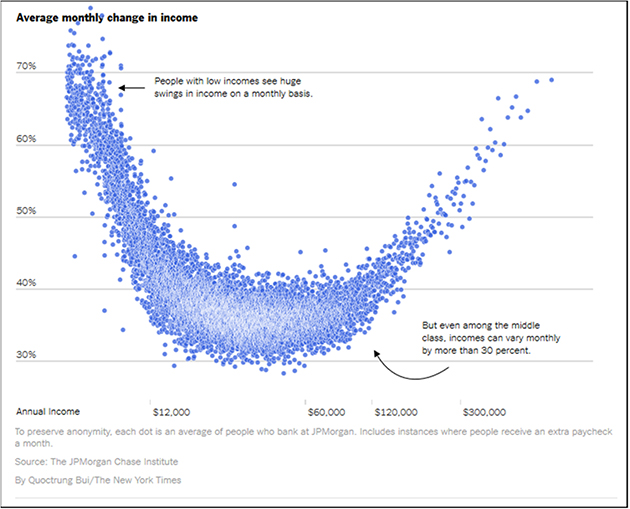Get Ready for the Fed’s Big Mistake
By Patrick Watson
America is fully employed, or so say the statistics. Federal
Reserve officials think the job market is strong enough to justify higher
interest rates. They’re afraid inflation will get out of control.
But if inflation is a problem, it’s not yet apparent in the
average worker’s paycheck. “Just wait,” the inflation hawks say.
Like many economic dilemmas, this one includes several big
assumptions. One is that having a job
means you have a steady income.
Maybe you want more, but you at least have some kind of reliable baseline.
A pile of evidence says that may no longer be a good assumption.
If so, Janet Yellen and whoever follows her will be making a huge mistake. We
all need to get ready for it.

Photo: AP
Persistent Puzzle
We all know people who are unemployed or underemployed – probably
more than the stats say we should. Are the official numbers wrong?
Yes, they could be flawed. But even if they’re right, it doesn’t
mean everyone is happy about it.
Maybe you lost your job because your company went bankrupt. No
other employers in your area need your skills. You can’t sell the house and
move because you’re underwater on the mortgage. With no better choices, you
take a lower-skilled job at half your former pay.
Someone like that shows up as “employed full-time” in the stats.
Yet they now live in a whole new world.
Such scenarios explain a lot of our discomfort. We have employment
stats, we have income stats, but we lack visibility on how they interact. This
makes a difference.
The New York Times
had an interesting story on this point last month.
Mirella Casares has what used to be considered the keystone of
economic security: a job. But even a reliable paycheck no longer delivers a reliable
income.
Like Ms. Casares, who works at a Victoria’s Secret store in Ocala,
Fla., more and more employees across a growing range of industries find the
number of hours they work is swinging giddily from week to week — bringing
chaos not only to family scheduling, but also to family finances.
And a new wave of research shows that the main culprit is not the
so-called gig economy, but shifting pay within the same job.
This volatility helps unravel a persistent puzzle: why a
below-average jobless rate — 4.4 percent in April — is still producing an
above-average level of economic anxiety. Turbulence has replaced the
traditional American narrative of steady financial progress over a lifetime.
“Since the 1970s, steady work that pays a predictable and living
wage has become increasingly difficult to find,” said Jonathan Morduch, a
director of the U.S.
Financial Diaries
project, an in-depth
study of 235 low-
and moderate-income households. “This shift has left many more families vulnerable
to income volatility.”
Sound familiar? It should, if you work in the retailing,
restaurant, or travel industry. They run 24/7 and constantly juggle staff
schedules to meet shifting demand.
Among other things, this makes it very hard to cobble together a
full-time income with two or more part-time jobs. The schedules inevitably
conflict. You can’t be two places at once.
Swinging Paychecks
Data from the JPMorgan Chase Institute shows income swings are
largest among the poor and the rich.
People on both ends of the income scale have similar variability
but they don’t feel similar pain.
Wealthy people have savings and/or the ability to borrow if cash
is low. For those on the lower end, an unexpected car repair or medical expense
at the wrong time can be catastrophic.
Does any of this show up in the unemployment rate? No. People can
be steadily “employed” but in terrible financial condition. And many are.
Maximum Monetary
Uncertainty
To the Fed’s Federal Open Market Committee, which meets this week,
this sort of thing is not part of the mandate. The law charges them with
maintaining full employment and price stability.
The problem here is that “full employment” doesn’t mean everyone
is OK. It can and does coexist with widespread financial misery.
Nevertheless, Janet Yellen and the other members see the sub-5% unemployment
rate as Mission Accomplished. It is their cue to stop promoting job creation and start fighting inflation.
This is why the Fed is (slowly) lifting interest rates and
planning to reduce its bloated bond portfolio. We might get more details
tomorrow.
Predicting what the Fed will do is even harder than usual right
now. The seven-member Board of Governors has three vacancies. President Trump
hasn’t nominated anyone to fill them.
Moreover, Janet Yellen and Vice Chair Stanley Fischer will both
likely retire in early 2018.
We could see five of seven seats change in the next year or less,
and we don’t yet know who will get them. We also don’t know how quickly the
Senate will confirm any new Fed governors.
Next year’s “dot plot” forecasts mean little when the key
dot-makers are halfway out the door and their replacements may have entirely
different ideas.
We are in a time of maximum monetary uncertainty. By this time
next year, the Fed could be…
- Still
on its present slow-tightening course
- Sitting
on its hands and doing nothing
- Raising
interest rates more aggressively
- Cutting
rates lower or even going negative
All those scenarios are completely plausible. Worse, they’re equally plausible. That makes
it very hard to have a matching investment strategy.
So what do you do?
This is a weird environment, and it’s tempting to just sit on your
hands and wait. But if you do that, you may have to wait a long time. You might
miss good opportunities, too.
The best answer is to be ready for anything.
See you at the top,



0 comments:
Publicar un comentario